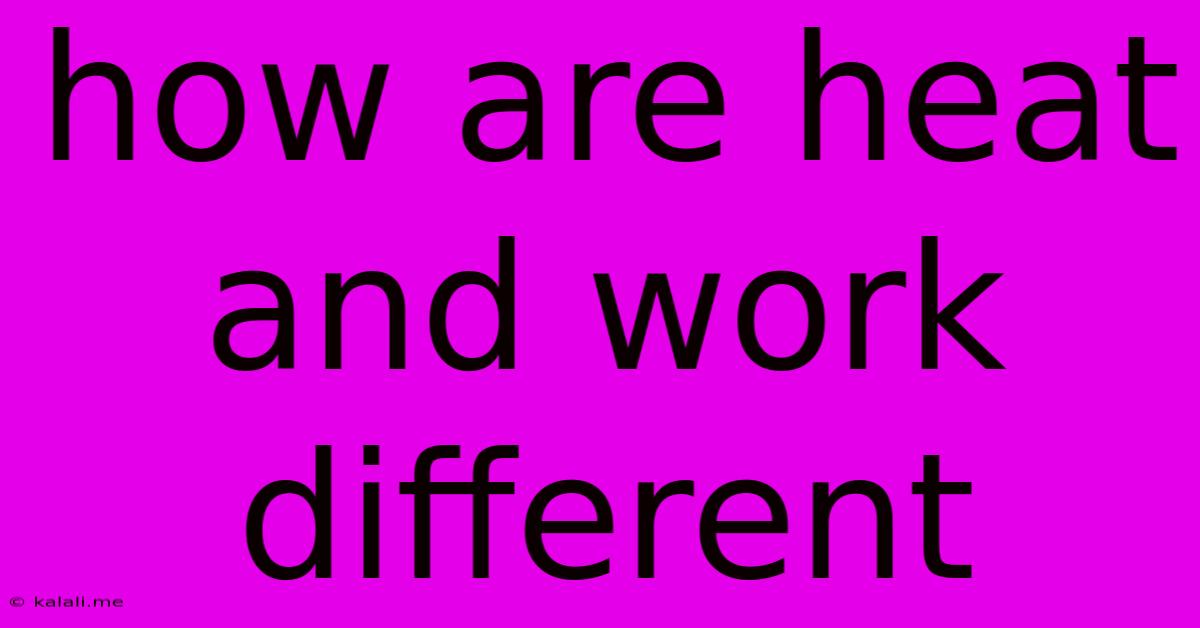How Are Heat And Work Different
Kalali
May 19, 2025 · 3 min read

Table of Contents
How Are Heat and Work Different? Understanding the Fundamentals of Thermodynamics
Heat and work are both forms of energy transfer, but they differ significantly in how that energy is transferred and the way they affect a system. Understanding this difference is crucial to grasping fundamental concepts in thermodynamics and physics. This article will explore the key distinctions between heat and work, providing a clear explanation for both beginners and those seeking a deeper understanding.
What is Heat?
Heat is the transfer of thermal energy between objects or systems at different temperatures. This transfer always occurs from a hotter object (higher temperature) to a colder object (lower temperature), driven by the tendency towards thermal equilibrium. Think of placing a cold spoon in a hot cup of tea – heat transfers from the tea to the spoon until both reach the same temperature. Key characteristics of heat include:
- Random molecular motion: Heat is associated with the random kinetic energy of the molecules within a substance. Higher temperatures mean faster, more chaotic molecular movement.
- Temperature difference: Heat transfer only occurs when a temperature difference exists. If two systems are at the same temperature, no heat exchange occurs.
- Spontaneous flow: Heat spontaneously flows from hotter to colder objects without external intervention.
What is Work?
Work, in the context of thermodynamics, refers to the energy transferred to or from a system by means of an applied force acting through a distance. Unlike heat, which involves random molecular motion, work involves organized, macroscopic motion. Examples include:
- Expansion/Compression of a gas: When a gas expands against an external pressure, it performs work on its surroundings. Conversely, compressing a gas requires work to be done on the gas.
- Lifting an object: Lifting a weight against gravity involves doing work on the object, increasing its potential energy.
- Stirring a liquid: The mechanical action of stirring a liquid transfers energy to the liquid as work.
Key characteristics of work include:
- Organized motion: Work involves organized, directed motion of macroscopic objects or systems.
- Force and displacement: Work is defined as the product of force and the displacement in the direction of the force.
- Can be positive or negative: Work done by a system is considered positive, while work done on a system is negative.
Key Differences Summarized:
| Feature | Heat | Work |
|---|---|---|
| Mechanism | Thermal energy transfer due to temperature difference | Energy transfer through force and displacement |
| Molecular Motion | Random, chaotic molecular motion | Organized, macroscopic motion |
| Direction | Always flows from hot to cold | Can be positive or negative |
| Measurement | Measured in Joules (J) | Measured in Joules (J) |
| Process | Spontaneous | Requires external force or action |
The Significance of the Distinction:
The distinction between heat and work is crucial in thermodynamics. The First Law of Thermodynamics, also known as the law of conservation of energy, states that the change in internal energy of a system is equal to the heat added to the system minus the work done by the system (ΔU = Q - W). This equation highlights the different ways energy can be transferred into and out of a system.
Understanding the difference between heat and work allows for accurate analysis of energy changes in various physical processes, from simple mechanical systems to complex chemical reactions and biological processes. It forms the bedrock of understanding concepts such as engines, refrigerators, and many other applications.
Latest Posts
Latest Posts
-
How To Stop Creaking Floorboards Under Carpet
May 19, 2025
-
How To Remove Paint From Painted Tile
May 19, 2025
-
Steering Wheel Vibrates At Higher Speeds
May 19, 2025
-
Does A Car Battery Charge While Idling
May 19, 2025
-
Lord Of The Rings Why Did Frodo Leave
May 19, 2025
Related Post
Thank you for visiting our website which covers about How Are Heat And Work Different . We hope the information provided has been useful to you. Feel free to contact us if you have any questions or need further assistance. See you next time and don't miss to bookmark.